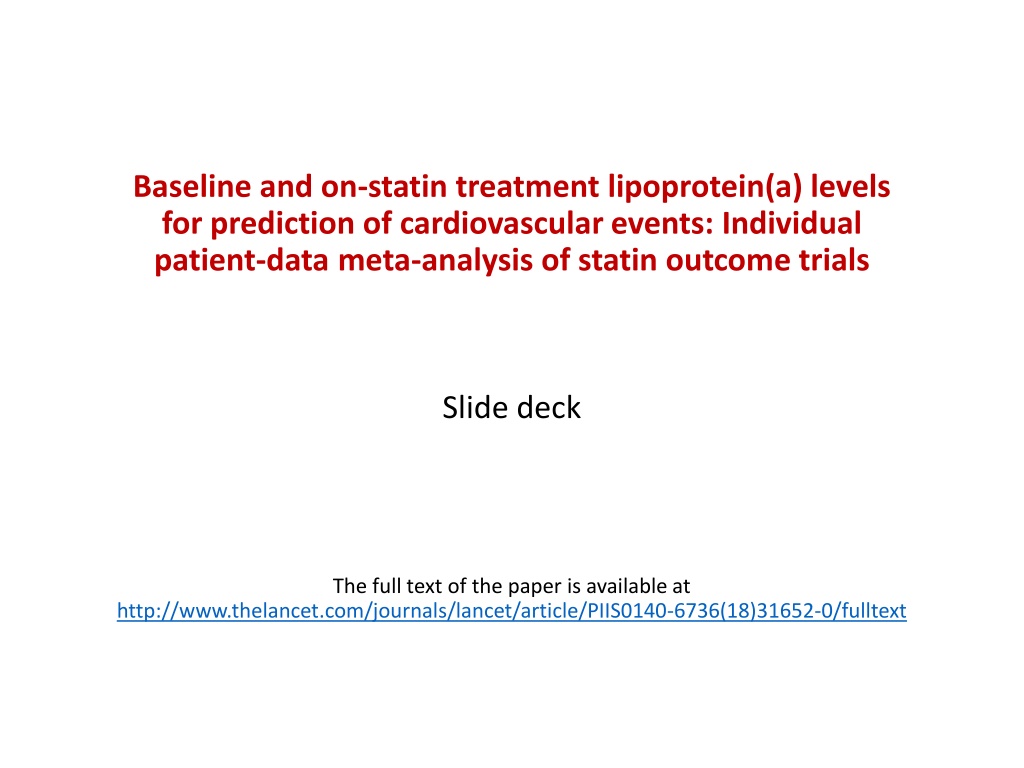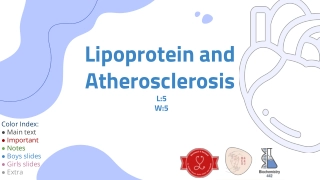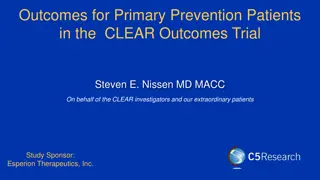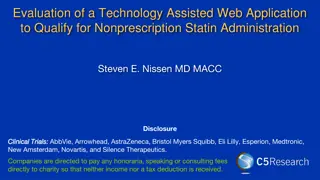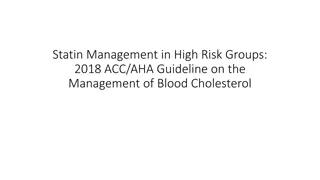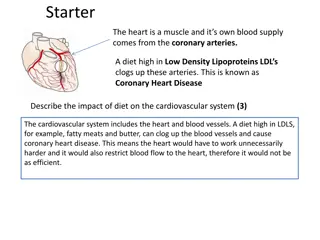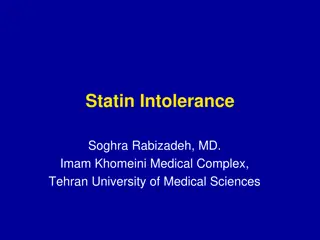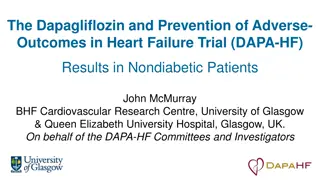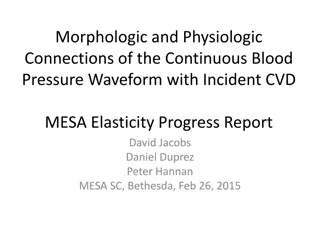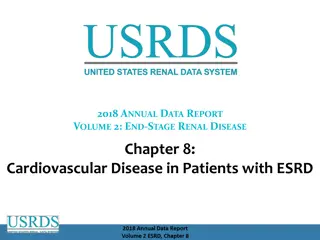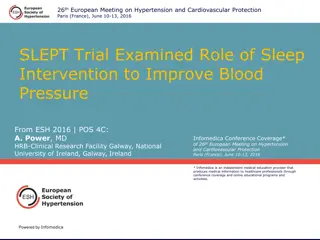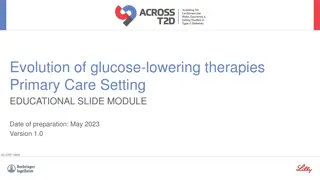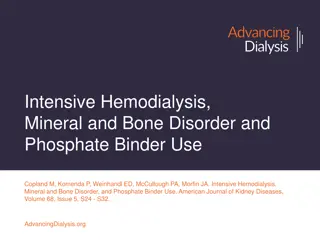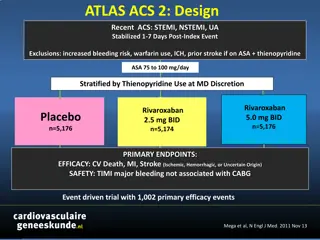Baseline Lipoprotein(a) Levels in Statin-Treated Patients for Cardiovascular Event Prediction
Lipoprotein(a) levels play a crucial role in cardiovascular disease risk assessment, especially in patients undergoing statin therapy. This individual patient-data meta-analysis from the Lancet explores the predictive value of lipoprotein(a) levels in 29,069 patients across seven landmark statin trials. Despite conflicting results from previous studies, this analysis sheds light on the significance of baseline lipoprotein(a) concentrations in patients on statin treatment. The study aims to clarify uncertainties and provide valuable insights for better CVD risk management in this patient population.
Download Presentation

Please find below an Image/Link to download the presentation.
The content on the website is provided AS IS for your information and personal use only. It may not be sold, licensed, or shared on other websites without obtaining consent from the author. Download presentation by click this link. If you encounter any issues during the download, it is possible that the publisher has removed the file from their server.
E N D
Presentation Transcript
Baseline and on-statin treatment lipoprotein(a) levels for prediction of cardiovascular events: Individual patient-data meta-analysis of statin outcome trials Slide deck The full text of the paper is available at http://www.thelancet.com/journals/lancet/article/PIIS0140-6736(18)31652-0/fulltext
Rationale Lipoprotein(a) is an established risk factor for cardiovascular disease (CVD) in the general population. The relevance of lipoprotein(a) concentration to CVD risk in patients on statin therapy is uncertain because statin trials: have yielded conflicting results and were uniformly underpowered as they involved only a small number of patients with high concentration of lipoprotein(a). To clarify this uncertainty, the Lipoprotein(a) Studies Collaboration analysed individual-level data on 29,069 patients involved in seven landmark statin trials. Willeit et al. Lancet 2018. http://dx.doi.org/10.1016/S0140-6736(18)31652-0
Design features of contributing trials Outcome definition Revascularisation Stable angina Years of baseline Comparator to placebo Stroke Trial Target population Lipid entry criteria, mmol/L Other MI AFCAPS 1990-1993 Primary prevention TC 4 65-6 82, LDL-C 3 36-4 91, TG 4 52, HDL-C 1 16and 1 22 LDL-C 4 14, TG 6 78 Lovastatin 20mg * CARDS 1997-2001 Type 2 diabetes Atorvastatin 10mg 4D 1998-2002 Type 2 diabetes + hemodialysis Primary prevention with C-reactive protein >2mg/dL Prior myocardial infarction or unstable angina Acute coronary syndrome Prior myocardial infarction or angina LDL-C 2 07-4 92, TG 11 3 Atorvastatin 20mg JUPITER 2003-2006 LDL-C <3 4, TG <5 65 Rosuvastatin 20mg LIPID 1990-1992 TC 4 0-7 0, TG <5 0 Pravastatin 40mg MIRACL 1997-1999 TC <7 0 Atorvastatin 80mg 4S 1989-1990 TC 5 5-8 0, TG 2 5 Simvastatin 20mg *includes TIA, PVD, sudden death, and deaths from other cardiovascular causes. Deaths from other cardiovascular causes. Willeit et al. Lancet 2018. http://dx.doi.org/10.1016/S0140-6736(18)31652-0
CONSORT diagram Willeit et al. Lancet 2018. http://dx.doi.org/10.1016/S0140-6736(18)31652-0
Patient characteristics Baseline AFCAPS CARDS 4D JUPITER LIPID MIRACL 4S Total Baseline No. of patients 1005 2470 1249 9612 7863 2431 4439 29069 Lp(a), mg/dL, median (IQR) 7 (3-17) 9 (5-22) 12 (5-42) 11 (5-23) 14 (7-44) 10 (5-29) 10 (4-28) 11 (5-29) <15 mg/dL 733 (73) 1658 (67) 709 (57) 5896 (61) 4118 (52) 1481 (61) 2654 (60) 17249 (59) 15-<30 mg/dL 134 (13) 310 (13) 129 (10) 1867 (19) 1147 (15) 362 (15) 781 (18) 4730 (16) 30-<50 mg/dL 84 (8) 212 (9) 140 (11) 851 (9) 877 (11) 223 (9) 714 (16) 3101 (11) 50 mg/dL 54 (5) 290 (12) 271 (22) 998 (10) 1721 (22) 365 (15) 290 (7) 3989 (14) Age, yrs 59 (7) 62 (8) 66 (8) 66 (8) 61 (8) 65 (11) 59 (7) 62 (8) Female sex 173 (17) 779 (32) 576 (46) 3556 (37) 1333 (17) 820 (34) 827 (19) 8064 (28) Prior CVD 0 (0) 6 (0) 513 (41) 0 (0) 7863 (100) 2431 (100) 4439 (100) 15252 (52) Diabetes 32 (3) 2470 (100) 1249 (100) 0 (0) 676 (9) 548 (23) 202 (5) 5177 (18) Current smoking 130 (13) 551 (22) 108 (9) 1492 (16) 735 (9) 693 (29) 1138 (26) 4847 (17) SBP, mmHg 136 (17) 144 (16) 146 (22) 136 (17) 134 (19) 128 (20) 139 (20) 137 (18) LDL-Ccorr, mmol/L 2 75 (0 78) 3 00 (0 86) 2 57 (0 49) 3 68 (0 74) 3 04 (0 86) 4 74 (0 66) 3 30 (0 67) HDL-C, mmol/L 1 64 (0 50) 0 94 (0 34) 1 35 (0 40) 0 96 (0 24) 1 20 (0 31) 1 19 (0 30) 1 21 (0 35) BMI, kg/m 26 (3) 29 (4) 28 (5) 29 (6) 28 (5) 26 (3) 28 (5) eGFR, mL/min 75 (17) 71 (17) 73 (17) Apo-B, g/L 1 16 (0 24) 1 10 (0 30) 1 08 (0 21) 1 33 (0 25) 1 16 (0 18) 1 17 (0 23) Willeit et al. Lancet 2018. http://dx.doi.org/10.1016/S0140-6736(18)31652-0
Patient characteristics Follow-up AFCAPS CARDS 4D JUPITER LIPID MIRACL 4S Total On-statin No. of patients 504 1255 616 4802 3941 1200 2218 14536 Time to Lp(a) repeat, yrs, median 1 0 2 5 0 5 1 0 1 0 0 2 2 5 1 0 Lp(a), mg/dL, median (IQR) 7 (3-19) 8 (4-22) 11 (5-40) 11 (4-25) 13 (6-43) 11 (5-33) 11 (4-33) 11 (5-32) <15 mg/dL 366 (73) 864 (69) 351 (57) 2912 (61) 2106 (53) 707 (59) 1268 (57) 8574 (59) 15-<30 mg/dL 59 (12) 134 (11) 60 (10) 868 (18) 548 (14) 175 (15) 321 (15) 2165 (15) 30-<50 mg/dL 43 (9) 103 (8) 73 (12) 417 (9) 439 (11) 96 (8) 375 (17) 1546 (11) 50 mg/dL 36 (7) 154 (12) 132 (21) 605 (13) 848 (22) 222 (19) 254 (12) 2251 (15) % change vs. baseline (95% CI) -1% (-6, 4) -13% (-15, -10) -6% (-9, -3) 2% (1, 3) -7% (-8, -5) 9% (6, 12) 15% (13, 17) -0 4% (-7, 7) LDL-Ccorr, mmol/L 1 68 (0 58) 1 73 (0 78) 1 43 (0 70) 2 57 (0 71) 1 56 (0 77) 2 97 (0 70) 1 99 (0 70) % change vs. baseline (95% CI) -37% (-38, -36) -41% (-43, -39) -43% (-44, -42) -29% (-30, -29) -47% (-49, -46) -37% (-37, -36) -39% (-43, -35) CVD incidence Follow-up, yrs, median (IQR) 5 6 (4 8-6 2) 4 1 (3 1-4 8) 2 4 (1 4-3 7) 2 0 (1 5-2 4) 5 4 (3 1-6 0) 0 3 (0 3-0 3) 5 3 (3 9-5 5) 3 0 (1 5-5 3) No. of events, overall 68 170 338 234 3040 537 1364 5751 No. of events, statin arm 31 71 166 81 1428 258 568 2603 Willeit et al. Lancet 2018. http://dx.doi.org/10.1016/S0140-6736(18)31652-0
Association of Lipoprotein(a) with CVD risk Comparison of groups with lipoprotein(a) levels of <15 mg/dL, 15 to <30 mg/dL, 30 to <50 mg/dL, and 50 mg/dL. Multivariable adjustment included age, sex, previous CVD, diabetes, smoking, systolic blood pressure, LDL cholesterol corrected for lipoprotein(a) cholesterol, and HDL cholesterol. Associations were independent of established risk factors. Willeit et al. Lancet 2018. http://dx.doi.org/10.1016/S0140-6736(18)31652-0
Predictive value of on-statin vs. on-placebo lipoprotein(a) concentration In an interaction analysis, the association of high lipoprotein(a) with CVD risk was stronger in patients allocated a statin than in patients allocated placebo. Willeit et al. Lancet 2018. http://dx.doi.org/10.1016/S0140-6736(18)31652-0
Predictive value according to clinically important patient characteristics Willeit et al. Lancet 2018. http://dx.doi.org/10.1016/S0140-6736(18)31652-0
Conclusion This meta-analysis demonstrates an approximately linear relationship of cardiovascular risk to levels of Lp(a), evident at Lp(a) levels 30-50 mg/dL, pronounced at levels 50 mg/dL, and persisting despite statin treatment. The data provide a rationale for evaluating drugs that can specifically lower Lp(a) and might have the potential to reduce residual cardiovascular risk independent of statin treatment. How to join the Lipoprotein(a) Studies Collaboration To contribute lipoprotein(a) data from your prospective cohort study or clinical trial, please get in touch with the coordinating centre via https://clinicalepi.i-med.ac.at/research/lpasc/ Willeit et al. Lancet 2018. http://dx.doi.org/10.1016/S0140-6736(18)31652-0
